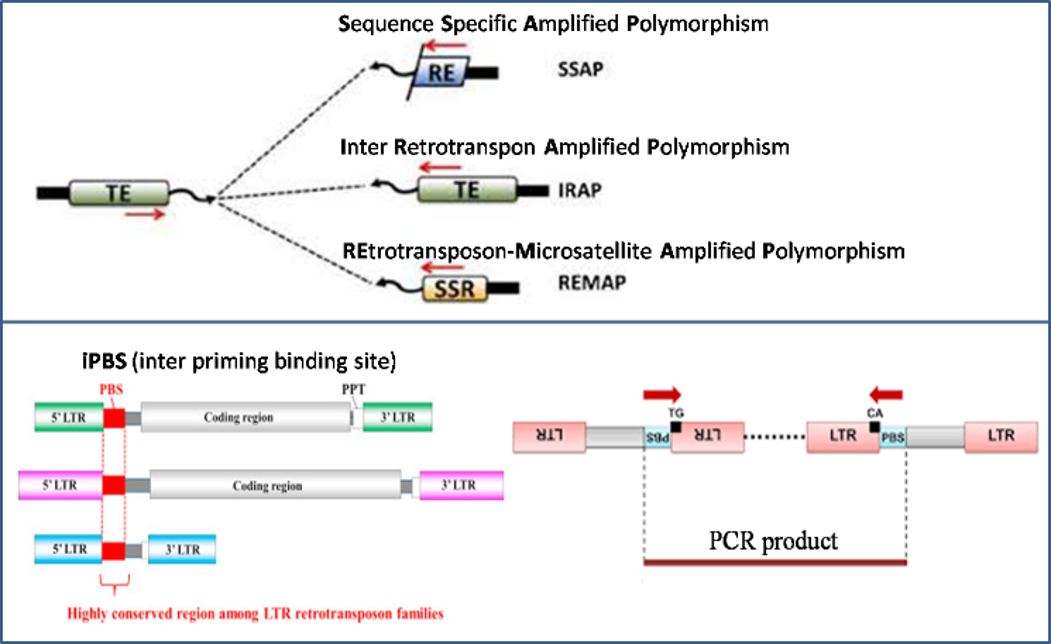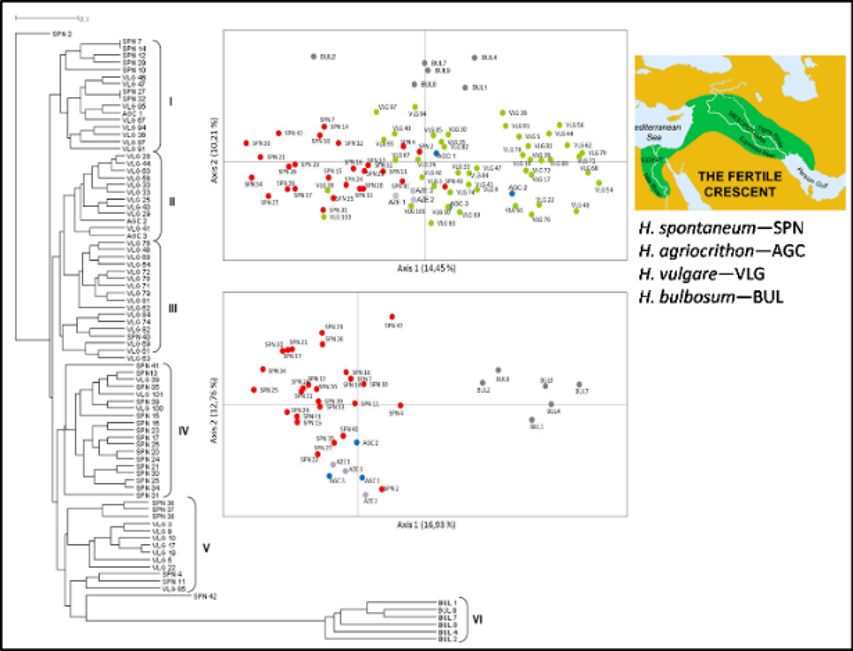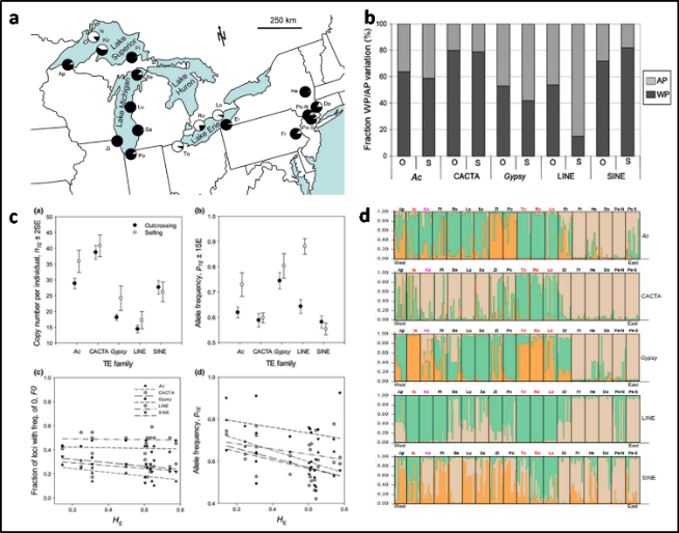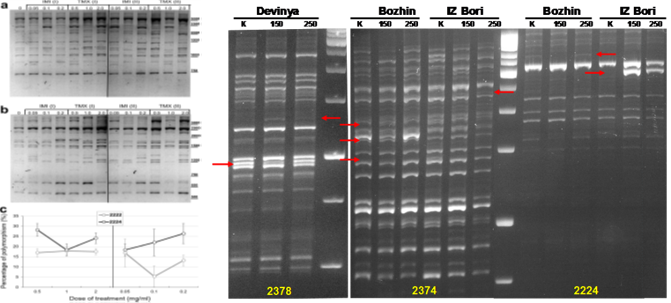GDS – Research topic 2
2. Mobile GENETIC ELEMENTS AS A MARKER SYSTEM FOR STYDUING GENOME DYNAMICS IN PLANTS
Transposable elements (TEs) or transposons are genomic regions having the capacity to move from one place into another in the host genome in a process called transposition. TEs are usually present in high copy number and have a wide genome coverage. In addition, the activation of TEs is often triggered in response to changes in the environment including biotic and abiotic stress factors. These features determine the relevance of TEs for the development of sensitive PCR-based multi-locus profiling techniques. Transposon-based markers such as SSAP, REMAP, IRAP, iPBS and Transposon Display have been successfully applied in our laboratory aimed at getting better insight into genetic mechanisms underlying natural and stressed-induced plant diversity and to unravel the role of TEs in the processes of genetic diversification, adaptation and evolution.

Scheme of retrotransposon-based markers SSAP, IRAP, REMAP and iPBS
а/ Genetic determinants of micro- and microevolution of plants
Transposon-based methods are effective for studying micro- and macroevolutionary changes in plants. In our laboratory, research has been performed to explore the genetic divergence in Hordeum and Triticum and the stages of domestication in these taxa.

Patterns of domestication and evolution of barley assessed by REMAP markers
The mating system is a key biological factor that influences the genetic diversity in living organisms at both individual and population level affecting parameters such as level of homozygosity, ectopic recombination, genetic drift and ecological distribution. One of the research topics addressed the interplay between mating system variation, genetic diversification and TE evolution in Arabidopsis lyrata populations differing in mating system from predominantly outcrossing to obligate selfing.

Interplay between mating system variation, genetic diversification and TE evolution in Arabidopsis lyrata
Read more:
Bonchev G, Dušinský R, Hauptvogel P et al. (2019) On the diversity and origin of the barley complex agriocrithon inferred by iPBS transposon markers. Genet Res and Crop Evol, 66: 1573–1586. https://doi.org/10.1007/s10722-019-00814-5
Bonchev G, Willi Y (2018) Accumulation of transposable elements in selfing populations of Arabidopsis lyrata supports the ectopic recombination model of transposon evolution. New Phytol., 219: 767-778. https://doi.org/10.1111/nph.15201
Bonchev G, Dusinský R, Hauptvogel P, Švec M (2017) Patterns of evolutionary trajectories and domestication history within the genus Hordeum assessed by REMAP markers. J Mol Evol, 84: 116-128. https://doi.org/10.1007/s00239-016-9779-z
b/ Plant genome dynamics in response to abiotic stress
Various retrotransposon-based markers have been routinely used for assessing the impact of abiotic stress factors like osmotic stress, chemical mutagens and radiation on genome stability in plants as a parameter of their tolerance.

TE-related genome dynamics in barley varieties induced by NaCl assessed by different iPBS primers
Read more:
Georgieva M, Bonchev G, Zehirov G et al. 2021 Neonicotinoid insecticides exert diverse cytotoxic and genotoxic effects on cultivated sunflower. Envl Sci Poll Res, 28: 53193–53207, https://doi.org/10.1007/s11356-021-14497-y
c/ Fingerprinting and characterization of plant germplasm resources for breeding practices
The precise identification and characterization of plant germplasm collections is of particular relevance for breeders for improving the breeding process but also to ensure a relevant genetic certification of the used breeding material. Methods of molecular marking offer great opportunities in this aspect especially for solving problematic cases of high varietal and within-varietal diversity at within-species level including the identification of somaclonal variants. Transposon-based markers for genome profiling have been used on a wide range of plant species including wheat, maize, sunflower and its relatives.

Genetic differentiation of wheat cultivars (a) representatives of the family Asteraceae and their intergeneric hybrids (b) based on iPBS markers
Read more:
Bonchev G, Vassilevska-Ivanova R (2020) Fingerprinting the genetic variation and intergeneric hybrid dynamics in the family Asteraceae (genera Helianthus, Echinaceae, Tagetes and Verbesina) using iPBS markers. Biologia, 75: 457–464 https://doi.org/10.2478/s11756-019-00363-3
Bonchev G, Shtereva L, Vassilevska-Ivanova R (2016) Retrotransposon-related genetic distance among inbred lines of sweet corn (Zea mays var. saccharata) and hybrid performance. Plant Genet Resour, 5: 1-9 https://doi.org/10.1017/S1479262116000411
